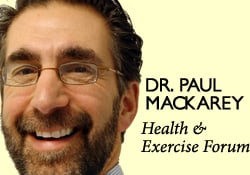
 Guest Columnists: Nancy Naughton, OTD, CHT; Casey Burke, DO
Guest Columnists: Nancy Naughton, OTD, CHT; Casey Burke, DO
Dirk Nowitski has had lots to add to his resume lately: NBA Championship, MVP of the playoffs, and—less glamorous, but still intriguing—a torn tendon in his middle finger. Since the first playoff game against the Miami Heat, there have been many questions and much speculation about the injury to Nowitski’s finger, which was made obvious by the tape on his finger.
The injury Nowitski sustained is referred to as a “mallet finger.” A mallet finger refers to a complete tear of the extensor tendon, which is the tendon that straightens the finger. This injury occurs when a ball or other object strikes the tip of the finger. Often, the tendon tears away from the point where it attaches to the bone. In children, mallet finger injuries may involve the cartilage that controls bone growth.
The finger is usually swollen, red, and painful. The fingertip may droop and will not be able to straighten it on its own.
Your physician may order x-rays to look for a fracture and may then refer you to an orthopedic/hand surgeon.
Some mallet fingers can be treated without surgery. Immediately following the injury, ice can be applied for swelling. Medical treatment should be obtained within one week. Treatment should be more immediate if the nail is detached or there is blood beneath the nail as these may be signs of a more serious injury, such as a nail bed injury or a serious fracture.
Your surgeon may refer you to a hand therapist. Initially, the therapist will make a splint that will fully straighten the fingertip. The splint must be kept in place for six weeks and not be removed. This will allow the injured tendon to heal appropriately. Night splinting may be continued for an additional 4-6 weeks. If the non-surgical treatment is not successful in regaining full extension or adequate finger function then you may be a candidate for surgery. A surgical repair may also be indicated if there are signs of bone fragments or a fracture.
Surgery is performed to reconnect the tendon to the bone. The surgeon may insert a metal pin in the finger to hold the joint straight. The pin would be removed approximately six weeks later.
Conservative and surgical treatments can both be successful, as long as the appropriate treatment is rendered. Although the appearance may not be perfect, the finger usually returns to a normal level of function.
If you do not seek medical attention, both the finger’s appearance and your ability to straighten the finger will not improve.
Other common sports-related hand injuries include “skier’s thumb” and “jersey finger.”
Skier’s thumb is an injury to a ligament at the base of the thumb. This injury occurs when the thumb is forcefully stressed in a direction away from the palm. If the ligament is partially intact, this injury may be treated non-surgically with splinting. A complete tear of the ligament may require surgery followed by immobilization.
Jersey finger is an injury to the flexor tendon on the palm side of the hand, which is responsible for bending your finger. It commonly occurs in football when grabbing the jersey of an opponent who is pulling away. With this injury, the finger would be unable to bend at the tip. Surgical repair is necessary for jersey finger.
As with all injuries, it is important to seek appropriate medical attention and follow the advised treatment recommendation. The injury may hold you back temporarily, but it doesn’t mean you have to be taken out of the game. Just ask Dirk Nowitski.
Sources: www.orthogate.org
Guest Columnists: Nancy Naughton, OTD, CHT is a certified hand therapist, Casey Burke, DO, is a specialist in orthopedic hand surgery; both are associated with Professional Orthopaedic Specialists, LTD, Scranton, PA.
Read “Health & Exercise Forum” – Every Monday. This article is not intended as a substitute for medical treatment. If you have questions related to your medical condition, please contact your family physician. For further inquires related to this topic email: drpmackarey@msn.com. Paul J. Mackarey PT, DHSc, OCS is a Doctor in Health Sciences specializing in orthopaedic and sports physical therapy. Dr. Mackarey is in private practice and is an affiliate faculty member at the University of Scranton, PT Dept.